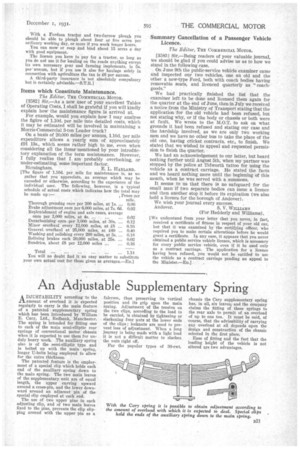An Adjustable Supplementary Spring
Page 55

If you've noticed an error in this article please click here to report it so we can fix it.
A DJUSTABILITY according to the 21.amount of overload it is expected regularly to carry is the main feature of a patented supplementary spring which has been introduced by William E. Cary, Ltd., Redbank, Manchester. The spring is intended for fitting -one to each of the main semi-elliptic rear springs of conventional motor' chassis when it is expected to use them for unduly heavy work. The auxiliary spring also is of the semi-elliptic type and is bolted up with the main spring, longer IT-bolts being employed to allow for the extra thickness.
The patented feature is the employment of a special clip which holds each end of the auxiliary spring down to the main spring. The two main leaves of the supplementary unit are of equal length, the upper curving upward around a cross-pin, and the lower downward around an adjacent pin of the special clip employed at each end.
The use of two upper pins in each adjusting clip, and of two main leaves fixed to the pins, prevents the clip slipping around with the upper pin as a fulcrum, thus preserving its vertical position and its grip upon the main spring. Adjustment of the tension on the two clips, according to the load to be carried, is obtained by tightening or slackening four nuts at the lower ends of the clips ; locknuts are used to prevent loss of adjustment. When a long journey is being made with a light load it is not a difficult matter to slacken the nuts right off.
For the popular types of 30-cwt.
chassis the Cary supplementary spring has, in all, six leaves,‘ and the company claims the fitting of these springs to the rear axle to permit of an overload of up to one ton. It must be said, of .course, that the advisability of carrying any overload at all depends upon the "design and construction of the chassis selected in the first place.
Ease of fitting and the fact that the loading height of the vehicle is not altered are two advantages
























































































